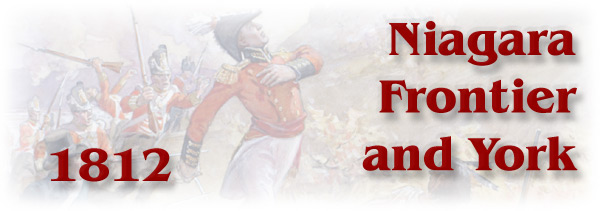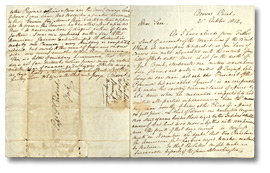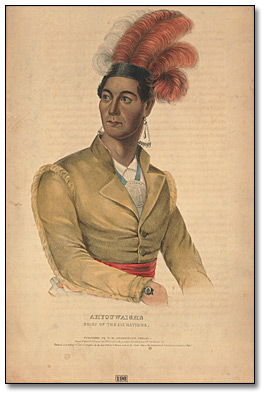
Table of Contents
Home | Setting the Stage | Battlegrounds | Militia and Civilian Life
Prisoners of War | Loyalty and Treason | The War Ends
After the War | Chronology | Soldiering in Canada
Important Figures | Important Places| Glossary
Sources | Links | The Making of a Virtual Exhibit
Brock was killed in this charge, along with his aide-de-camp Colonel Macdonell, and command transferred to General Sheaffe who was responsible for the defence of the Niagara area. |
![Watercolour: The Death of Brock at Queenston Heights, [ca. 1908] Watercolour: The Death of Brock at Queenston Heights, [ca. 1908]](pics/619871_brock_270.jpg) Click
to see a larger image (210K) | |
|
While the U.S. forces increased their strength on
the Canadian side of the River, General Sheaffe moved his mixed
force of Regulars, Militia and First Nations troops around the
flank of the invaders. |
||
 Click
to see a larger image (206K) |
|
|
|
The village of Queenston
developed in the 20 years before the war along the river's edge
and up the bank to the base of the Heights. |
||
![Watercolour: Queenston Barracks, [ca. 1793] Watercolour: Queenston Barracks, [ca. 1793]](pics/6921_queenston_barracks_270.jpg) |
The Battle of Queenston Heights was fought in this vicinity. General Brock was killed in the area shown as a clearing behind the barracks. Click
to see a larger image (223K) |
|
Click
to see a larger image (115K) |
|
|
|
||
| Ahyouwaighs
(John Brant) (left above) supported the British throughout
the War of 1812, participating in the Battle of Queenston Heights
and encouraging other members of the Six Nations from along Grand
River to fight the American invaders. |
||
General Isaac Brock's death at the battle was considered both heroic and a severe loss to the military effort. Brock's leadership early in the war had been an important factor in preventing an early and probably irreversible victory by the United States. A permanent memorial to him and the victory at Queenston was planned soon after the war ended.
|
||
| [ Return to top
of page ] |
||

 he first significant engagement of the war and certainly the best
known to Ontarians was the Battle of Queenston Heights,
13 October 1812 , fought near Niagara Falls. The American attack
was initially successful. A large force crossed the Niagara River
and was able to outflank the British forces on the Heights and
force their retreat from the artillery batteries. General Brock
arrived with reinforcements from Fort George and launched an immediate
counter-attack, which was repulsed.
he first significant engagement of the war and certainly the best
known to Ontarians was the Battle of Queenston Heights,
13 October 1812 , fought near Niagara Falls. The American attack
was initially successful. A large force crossed the Niagara River
and was able to outflank the British forces on the Heights and
force their retreat from the artillery batteries. General Brock
arrived with reinforcements from Fort George and launched an immediate
counter-attack, which was repulsed.
